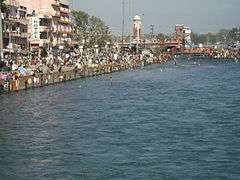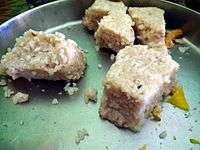Mesha Sankranti
| Mesha Sankranti | |
|---|---|
 Ganges at Haridwar, Uttarakhand | |
| Official name | Mesha Sankranti or Mesha Sankramana |
| Type | Seasonal.Religious (Hindu). |
| Significance | Solar new year. Regional new year festivals. |
| Celebrations | Bathing in holy waters |
| Date | day when the Sun enters the Aries Zodiac. (mid-April) |
| 2015 date | 14 April |
| 2016 date | 13 April |
Mesha Sankranti (also called Mesha Sankramana) is a Hindu festival and refers to the day when the sun enters the Zodiac sign of Mesha (Aries). The day represents the vernal (Spring) equinox which occurs around 21 March but the day is marked in April.[1] The day is important in solar and lunisolar calendars followed on the subcontinent. Mesha Sankranti is a solar event and generally falls on 13 April[2] but sometimes also falls on 14 April according to the Gregorian calendar. A number of festivals are celebrated on this day.
Observance
Many regional calendars have two elements: lunar and solar. The lunar element is based on the movement of the moon and counts each month from either new moon to new moon, full moon to full moon,or the day after the full moon to the next full moon.[3] The lunar element forms the basis of religious calendars and begin the year in Chaitra.[4] Many regions begin the local new year with the commencement of the lunar calendar: Gudi Padwa in Maharashtra; Cheti Chand for the Sindhi community;[5] and Navreh in Kashmir.[6] In Gujarat, the regional year commences with the lunar month of Kartika after Diwali.[7]
The solar element of lunisolar calendars begin the year in Vaisakha[8] on Mesha Sankranti hence why the day is also called Vaisakha Sankranti. This day is observed by people across India, even in regions which begin the new year using the lunar calendar. However, some regions also begin the regional new year on Mesha Sankranti (see below).
Festivals
Mesha Sankranti Festival
Also known as Vaisakha Sankranti, Mesha Sankranti is observed by people to mark the solar new year irrespective of when the regional new year is observed. The festival is very important for Hindus. People bathe in waters and make pilgrimage to holy places such as Haridwar.[9] In Bihar, the day is celebrated as Satuan which involves people bathing and then eating sattu and jaggery. The sun god is also worshipped.[10]
New year festivals
Bikhoti festival
The Bikhoti Festival of Uttrakhand involves people taking a dip in holy rivers. A popular custom involves beating symbolic stones representing demons with sticks. The fair is celebrated in various major centres including Sealdah, Bageshwar and Dwarahat and involves much singing and dancing, accompanied by local drums and other instruments.[11]
Vishu

Vishu of Kerala[12] is considered a festival of light and fireworks, and decorating lights and bursting of firecrackers (Vishupadakkam) is part of the celebration. Other elements of Vishu include buying of new clothes (Puthukodi) for the occasion, and giving money called Vishukkaineetam, the Vishu feast or Sadya, consisting of equal proportions of salty, sweet, sour and bitter items. Feast items include Veppampoorasam, Mampazhappulissery, Vishu kanji and Vishu katta'. People also observe Vishukkani: "the first thing seen on the day of Vishu after waking up". The Vishukkani consists of rice, fruits and vegetables, betel leaves, arecanut, metal mirror, yellow flowers called 'konna' (Cassia fistula), holy texts and coins.
Bohag Bihu
Bohag Bihu or Rangali Bihu marks the beginning of the Assamese New Year on April 13th. It is celebrated seven days after Vishuva Sankranti (Mesha Sankranti) of the month of Vaisakh or locally 'Bohag' (Bhaskar Calendar). The three primary types of Bihu are Rongali Bihu, Kongali Bihu, and Bhogali Bihu. Each festival historically recognizes a different agricultural cycle of the paddy crops. During Rangali Bihu there are 7 pinnacle phases: 'Chot', 'Raati', 'Goru', 'Manuh', 'Kutum', 'Mela' and 'Chera'.
Vaisakhi

Vaisakhi of the Punjab region heralds the new year where fairs are held and Bhangra and Giddha folk dances take centre stage.
Pana Sankranti
Pana Sankranti also called Maha Vishuva Sankranti marks the Oriya new year in Odisha. Celebrations include filling a small pot with pana or a sweet drink of Mishri and water in front of residence,hosting of sacred flag on top of house, reading New almanac; consuming flour of horse gram, banana and curd. Danda Nacha or Danda Nata of Odisha is a tribal dance which is performed to mark the new year.
Pohela Boishakh
The Bengali new year is celebrated as Pohela Boishakh, a day after Mesha Sankranti known as Boishakh Sankrant.
The festival is celebrated as a national holiday in Bangladesh. Pohela Boishakh is also known as Nobo Barsho as it is the first day of the Bengali month of Bongabdo. Fairs are organised to celebrate the event which provide entertainment including the presentation of folk songs.
Puthandu
Tamil people celebrate the Tamil new year on 14 April. This is the month of Chitterai, the first month of the Tamil solar calendar in Tamil Nadu.
Edmyaar 1 (Bisu Changrandi)
The Kodava new year is celebrated as Bisu Changrandi.
Jurshital in Bihar
In the Mithal region of Bihar and Nepal, the new year is celebrated as Jurshital.[13] It is traditional to use lotus leaves to serve sattu (powdered meal derived from grains of red gram and jau (Hordeum vulgare) and other ingredients) to the family members.[14]
See also
References
- ↑ Journal of the Asiatic Society of Bengal, Volume 3 (1869) Asiatic Society
- ↑ Hubert Walter Codrington, Humphrey William Codrington (1996)
- ↑ Frank Parise (2002) The Book of Calendars
- ↑ L.D.S. Pillai (1996) Panchang and Horoscope
- ↑ Mark-Anthony Falzon (2004) Cosmopolitan Connections: The Sindhi Diaspora, 1860-2000
- ↑ Explore Kashmiri Pandits
- ↑ S. Balachandra Rao. Indian Astronomy: An Introduction
- ↑ P. Kenneth Seidelmann (2005) Explanatory Supplement to the Astronomical Almanac
- ↑ The Tribune 15 April 2015 Mesh Sankranti: Pilgrims take dip in Ganga
- ↑ Anirudha Behari Saran, Gaya Pandey (1992) Sun Worship in India: A Study of Deo Sun-Shrine
- ↑ Festvals and Culture
- ↑ Kumar Suresh Singh.People of India, Volume 27, Anthropological Survey of India (2002)
- ↑ Hari Bansh Jha (1993) The terai community and national integration in Nepal.
- ↑ Ethnobotany (2002)Aavishkar Publishers
